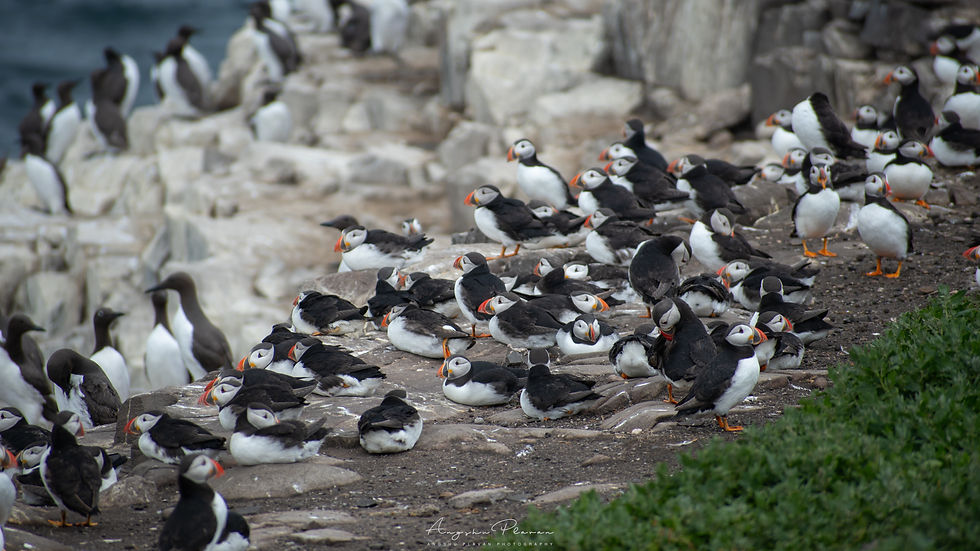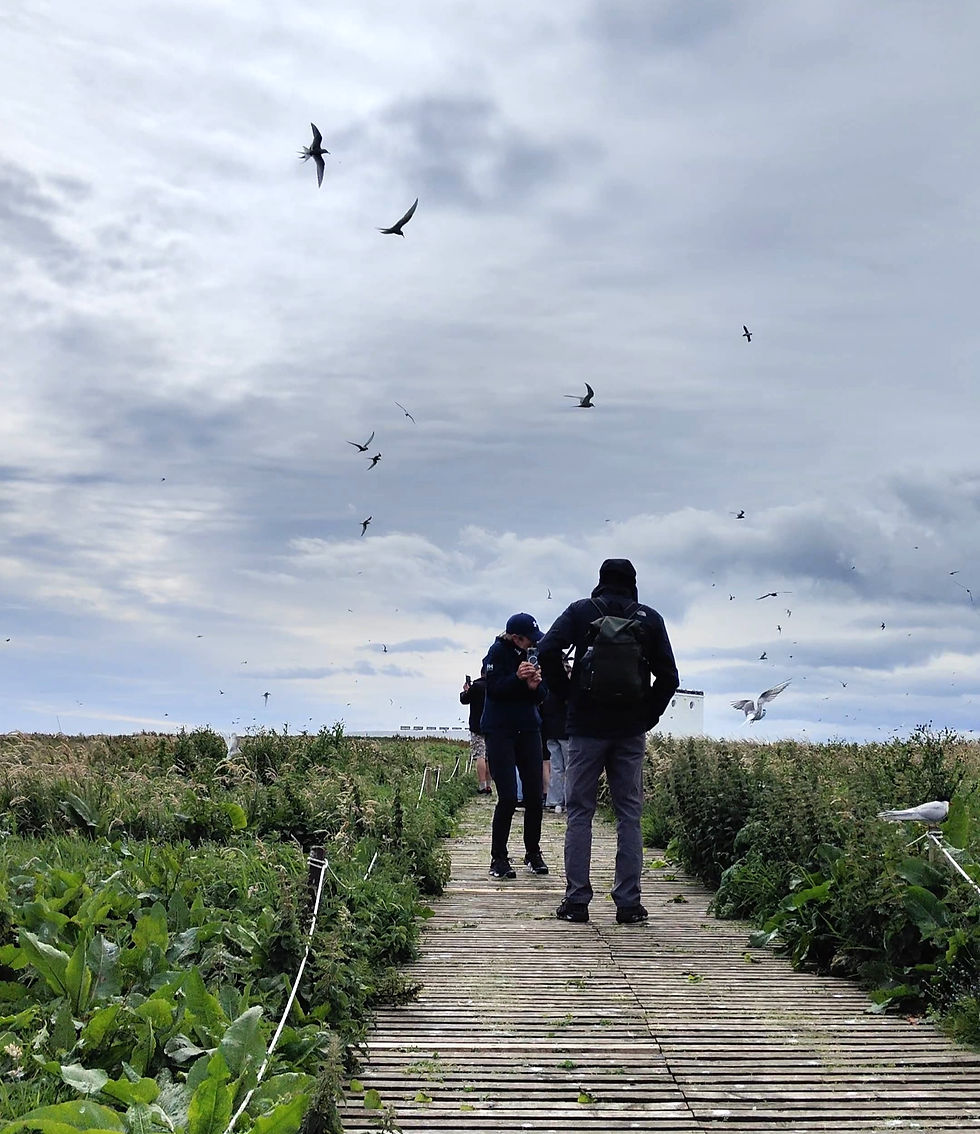A Day Among the Seabirds: Exploring Farne Islands' Feathered Kingdom
- anthracoceros602
- May 25
- 6 min read

Imagine standing on the edge of a rugged cliff, the wind carrying the crisp scent of saltwater as the air vibrates with the flurry of wings. All around you the sky is alive, puffins with their bright beaks darting through the breeze, guillemots nesting in tight clusters on rocky ledges, and Arctic terns slicing through the sky with graceful precision. The cacophony of calls echoes across the waves, a symphony of nature in full swing. This is the Farne Islands—a haven for birdwatchers and nature lovers, where the boundaries between land, sea, and sky blur into one breathtaking spectacle.
Driving to Seahouses
Our journey began with the hum of excitement as we picked up our self-drive car from Newcastle Airport. The morning air was crisp, carrying a hint of adventure as we loaded our bags and settled in for the drive ahead. Before hitting the road, we made a quick stop at Greggs in the airport, grabbing some sausage rolls and sandwiches, fuel for the journey ahead. Our ride for the trip was a bright red Fiat 500, a tiny but stylish little car that felt just right for this countryside adventure. With the map set, we joined the A1, the arterial road that threads its way through the heart of Northumberland. As we left the bustle of Newcastle behind, the landscape began to change, urban sprawl giving way to stretches of lush countryside. Rolling green hills lined with dry stone walls sprawled out on either side, punctuated by quaint villages and the occasional herd of sheep grazing peacefully. It felt like driving through a postcard of the English countryside. It was the kind of drive that makes you want to pull over every few miles just to soak in the scenery.

The drive took us past Alnwick, known for its historic castle, and through small towns like Shilbottle and Longframlington, with occasional glimpses of the North Sea glimmering in the distance. As we approached Belford, the scenery became even more dramatic. The Northumberland Coast National Landscape stretched out to our right, with hints of sand dunes and rugged cliffs teasing what was to come. Finally, after about an hour and forty minutes of idyllic driving, we found ourselves in Seahouses, the charming coastal village that serves as the gateway to the Farne Islands.
Setting Sail
The salty sea breeze carried the cries of seagulls as we parked the car and made our way towards the docks. Seahouses is bustling with options when it comes to exploring the Farne Islands, with several tour operators offering various packages, some focusing solely on coastal cruises, while others include landings on the islands. We opted for Serenity Farne Island Boat Tours, known for its experienced crew and well-organized trips. One important detail for those planning to step foot on the islands: landing on the Farne Islands requires a separate ticket from the National Trust. For members, the landing is free; non-members need to purchase the ticket, which helps fund conservation efforts. Access to the islands is tightly regulated, with time slots managed carefully to minimize disturbance to the wildlife. This ensures that the vibrant bird colonies can thrive without excessive human interference.
Sailing Through the Farne Islands: A Wildlife Wonderland
As the boat left the harbor, the distant silhouettes of the Farne Islands began to take shape against the horizon. The Serenity boat tour is designed to navigate around the entire cluster, providing breathtaking views of the various islets that make up this extraordinary archipelago. Seabirds soared above us, their calls blending with the rhythmic splash of waves against the hull.
The captain guided us around the Outer Farne Islands, giving us a glimpse of the rugged coastlines where grey seals lounged lazily on rocky outcrops with the Longstone Lighthouse towering majestically in the backdrop. The sight was almost surreal—the seals lay sprawled out, occasionally glancing up with mild curiosity before settling back into their slumber.
Fun Fact: Did you know that grey seals are almost always pregnant? These marine mammals have gestation periods lasting nearly 11 months. Amazingly, right after giving birth, female seals go through a brief resting period before getting pregnant again. Essentially, a grey seal's life is a near-continuous cycle of pregnancy and motherhood!
The boat slowed near Staple Island and Longstone, famous for their dramatic cliffs and dense bird populations. Cameras clicked frantically as flocks of guillemots, razorbills, terns, gannets, gulls and kittiwakes swept through the air in synchronized chaos. In a stark reminder of nature's rawness, we watched a seagull ruthlessly munching on a baby kittywake, wings flapping frantically as it held its prey. It was a harsh glimpse into the survival instincts that govern life in these islands, a reminder that nature, while beautiful, is also unapologetically brutal.

Finally, we approached the crown jewel of the tour: Inner Farne. This is the largest and most accessible of all the islands, a true paradise for birdwatchers and wildlife photographers. The boat docked gently, and we disembarked onto a path teeming with life. It was immediately clear why Inner Farne is renowned—birds were everywhere! Puffins zipped in and out of burrows with beaks full of sand eels, Arctic terns flitted gracefully above, and eider ducks bobbed in the shallow waters nearby. With limited time on the island, we made the most of every minute, capturing photographs and simply soaking in the incredible spectacle of nature in its purest form.
To protect the island’s delicate ecosystem, especially the nesting chicks and burrow-dwelling birds like puffins, wooden plank pathways have been thoughtfully installed. Visitors are strictly required to stay on these designated paths, ensuring that the wildlife remains undisturbed and safe during the critical breeding season.
Puffins
Often called the Clowns of the Sea due to their bright orange beaks and comically expressive faces, puffins are a true highlight for wildlife enthusiasts. During the breeding season, these charismatic birds flock to the islands in their thousands, burrowing into the soft soil to create their nests. Despite their somewhat clumsy appearance on land, puffins are exceptional flyers and even better swimmers, using their wings to "fly" underwater in pursuit of small fish like sand eels. Watching them zip back to their burrows with beaks full of shimmering fish is a sight that never gets old.
Arctic Terns, Guillemots, and Kittiwakes: The Winged Residents of Farne Islands
Among the bustling birdlife of the Farne Islands, three species stand out for their sheer numbers and unique behaviors: the Arctic Terns, Guillemots, and Kittiwakes. Arctic Terns are known for their jaw-dropping migrations, traveling over 70,000 kilometers each year from the Arctic to the Antarctic and back, the longest migration of any animal on Earth. These elegant fliers are fiercely territorial during breeding season, often swooping at visitors who stray too close to their nests. Guillemots, on the other hand, are masters of vertical living. They crowd together in packed colonies on narrow cliff ledges, balancing their eggs precariously without the comfort of a traditional nest. Their sleek black-and-white plumage and upright stance give them a distinctive look, almost penguin-like from a distance. Finally, the Kittiwakes add their own charm to the islands, nesting on rocky crags and cliff faces, their constant cries giving them their name. With graceful glides and dramatic dives, they dot the skies around the islands, adding to the vibrant tapestry of life that defines the Farne Islands.
A word of caution: if you visit during the breeding season, bring a hat/cap. The Arctic terns are fiercely protective of their nests and they swoop at visitors who stray too close. Their tenacity is both amusing and impressive, a sign of just how dedicated they are to protecting their young.
The Coastal Drive to Ross Sands and Holy Island Causeway
After an unforgettable time exploring the wild beauty of Farne Islands, we returned to Seahouses, still buzzing with excitement. We then continued our journey north along the A1, winding through scenic backroads that hugged the Northumberland coast. Our next destination: the secluded stretches of Ross Sands and the famous Holy Island Causeway.
The drive to Ross Sands was a journey through rolling farmlands, punctuated by the occasional stone cottage and grazing sheep. Unlike the more tourist-heavy spots, Ross Sands remains relatively untouched, with no signposts or car parks, just a hidden gem known to locals and those who seek out its pristine shores. We parked just off the main road and followed a winding path flanked by marshy fields, wildflowers and towering dunes before the coastline unfolded in front of us. The vast stretch of golden sand seemed almost infinite, lapped by gentle waves and dotted with driftwood. In the distance, the imposing silhouette of Bamburgh Castle and Lindisfarne Castle stood proudly against the sky, adding a touch of medieval grandeur to the scene.
After soaking in the solitude of Ross Sands, we continued our drive towards Holy Island Causeway. The road twisted and turned, eventually leading us to the causeway, a narrow strip of tarmac that vanishes under the tide twice a day. Timing is everything here; cross too late, and the North Sea will reclaim the road, leaving you stranded until the tide recedes. We arrived right on schedule, the sea calmly lapping at the edges as we began the surreal drive across the causeway.
As the day waned, we reluctantly turned from the spell of Holy Island. The road home wound through the coastal Villages quiet and quaint, bathed in the amber glow of the setting sun. The sky transformed into a painter’s dream, streaked with coral, lavender, and the deepest hues of blue. The Northumberland coast had unfolded its soul before us, a place where wild beauty, quiet reverence, and deep serenity live in perfect harmony. Though we reached the end of this journey, our hearts remained anchored there, caught in the hush of the wind and the pulse of the sea.
(Non affiliated) Link to the tour we took: https://farneislandstours.co.uk/inner-farne/






















































































Comments